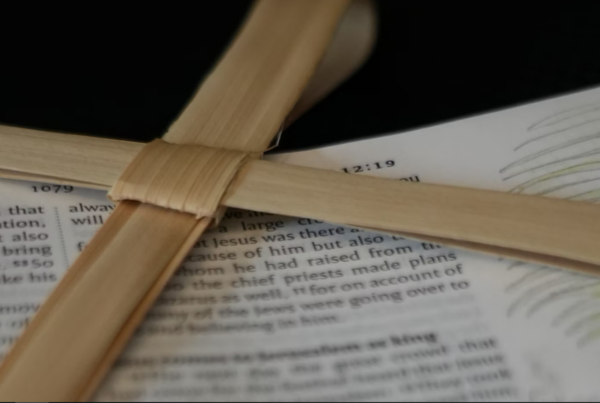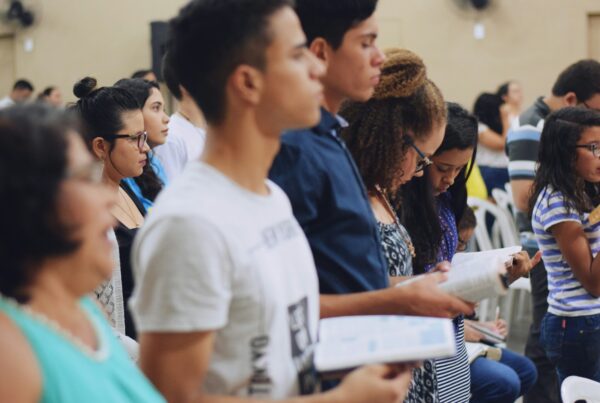Midway through the COVID-19 pandemic, pastor burnout became a huge concern in the church world.
Rev. Billy Norden has a unique perspective on clergy burnout. For the last two years, he has administered clergy revitalization grants for pastors in the Reformed Church in America, with financial support from the Lilly Endowment, Inc.—and he recently transitioned from pastoral ministry to a new call serving the RCA’s Board of Benefits Services. I asked Billy about clergy well-being, burnout, and what he’s learned from awarding 126 clergy revitalization grants.
This is a condensed version of our conversation and has been lightly edited for clarity.
The Board of Benefits Services had two successive grants from the Lilly Endowment, Inc. as part of their “economic challenges facing pastoral leaders” program. Near the end of that second grant, you totally changed your approach and began to offer clergy revitalization grants. Why was that important, and why was it so urgent?
Most of our work with the grant focuses on very tangible economic things for ministers like debt—the debt that they carry out of seminary in order to be pastors, living on financial margins that are sometimes too small. But it was about so much more than money. What it’s really about is well-being. The research that backed the economic challenges grant showed that ministers who are under stress about not having enough finances for everyday life tended to have a low level of well-being. It weighed on them every day, day in and day out, so that’s what we were trying to alleviate. We were trying to increase well-being among clergy, knowing that that was a key way to do it.
So the pandemic hits. We think we’re just on the tail end of our grant. The Lilly Endowment realizes that there is not only more work to be done with economic challenges, but the pandemic might have shifted the challenges that pastors now face. And so we did a big listening session to many of our clergy, saying, “What are your challenges right now? What are your economic issues in light of the pandemic?”
What we learned over and over again was that while church budgets might not have been catastrophic because of the pandemic, the well-being of clergy was at an all time low. So many of our clergy were in the midst of burnout.
It became very clear to us that they didn’t have the time, resources—the human resources, or the financial resources—to care for themselves physically, spiritually, and emotionally. That caused us to go to the Lilly Endowment for a surprise phase three of our grant and say: we think that this actually is an economic challenge, and we want to offer some money to our pastors so that they can experience a revitalization leave from their ministry context, in hopes that it gives them more endurance, stamina, and joy for ministry.
Your grants provided a three-week mini-sabbatical and $3,000 for clergy. What kind of renewal activities did the pastors use the money for? Are there some common themes?
One of the themes that kept coming up continually was being in nature. A lot of our folks retreated to those simple, still places in the world, away from the busyness and away from the cities, but into nature.
We also saw a lot of pastors pursuing recreations that brought them joy and full life. So some went on fishing trips, others attended bucket list concerts with their siblings. Some went golfing with old friends, and some, you know, did things like hiking or walking on the beach.
We also saw many of our pastors seeking communities of spiritual retreat. For some that was as straightforward as a conference, or going to Quiet Waters, which is a popular destination for ministers seeking healing. But there were monasteries, communes, the Iona community in Europe—there were all sorts of places that really facilitate spiritual depth and healing.
Was there anything pastors couldn’t use the money for?
We wanted to be really clear that a mini-sabbatical was different than vacation. Our pastors are driven people, and they have a desire, but also a pressure, to produce. And so sometimes in an application, we would see something that was very heavily oriented towards education, or working on some aspect of their ministry. And we didn’t grant those because we needed something that would give people space from those things.
Speaking of filling the tank for ministry, is a mini-sabbatical enough to prevent burnout?
This was a question that we had going into this, because we weren’t sure. The Lilly Endowment has a wonderful clergy renewal program that offers sabbatical grants and their core conviction is, it’s got to be three to four months to have a real sabbatical experience.
We did this hesitantly, knowing that we couldn’t fund three to four months for all the pastors we wanted to touch with this.
So we just stepped out on a limb, hoping that this would do something fruitful, and the results have been pretty great. Most of our pastors have come back to us, and said, “I was really surprised at how good this was for me.” Because everybody had the same concern as us! They thought, “Is this really enough to make a difference? It’ll take me a couple of weeks just to wind down from the craziness of the past few years.”
But they had made a plan. There was intention in meeting with a professional helper to guide them through the process. And they were doing something that they hoped would bring them life, and they were intentionally getting right into it. We had pastors say, “I didn’t think that it would be that impactful. But it was completely renewing and revitalizing.”
All of those same pastors say, “You know, it wasn’t the magic bullet. The problems are still here, but it gave me enough of what I needed to take on this next chapter of ministry.” That was most of of the responses we got. There were some that said, “It wasn’t enough. I’m still weary,” or “It was good, but I feel like I’m sort of back in that grind or that hard spot.”
It didn’t fix everything, but it was really pleasantly surprising to see just how much value it brought to pastors and churches in most cases.
You mentioned a professional helper. What do you mean by that?
All applicants for the grant put together a personal health plan that included a professional helper. Most pastors either saw a therapist or a spiritual director. Some went to a retreat that was facilitated by some sort of professional that would be able to guide, and help and heal.
That was easily one of the most valuable things. Most of our pastors found that they did more sessions than they planned for in their application, because it was so good. It was affirmed for us that it was really good that we required this, because that outside person to help guide, to ask good questions, and to help our pastors get outside of themselves in their context—that was just really helpful and important.
Okay, so what else can pastors and congregations do to keep ministries sustainable for their leaders?
I think this is a question of purpose and focus.
We all have also seen a number of clergy leave ministry, or they’ve lost motivation for it.
Having a clear focus about what the congregation is about—their mission or vision for their context in their community—seems to be something that’s really important.
What a lot of pastors saw during COVID was people leaving church for a while, and a decent number of them saying, “That is just not not an important part of our lives anymore.” For the minister whose vocation and passion is around the gathered community, that’s pretty devastating.
What we saw with a lot of these congregations, too, is that those congregations that had a more clearly-articulated vision for what they were about together, tended to gain momentum with the relationship between the pastor and the congregation.
For me it comes down to purpose. Does the congregation know its purpose, and does the pastor feel like they have a purpose there?
Those are the things that, once these pastors have gone on sabbatical, they have that reignited sense of purpose. They can go back in and have the energy for it. But some really questioned, “What am I doing here? Is this worthwhile for me?” That’s where you started to see some pastors hopping to other careers or fields, because they felt like they were just spinning their wheels, doing the same thing over and over again week after week, for a community that maybe didn’t appreciate them or wasn’t willing to have a discussion about what they were about together, as far as the shared purpose goes.
Two things that came up for me is having a shared purpose together, and then, being willing to let go of activities and programs that need to be let go—the things that weren’t adding to the life of either the congregation, the community, or the pastor.
Ken Eriks, who used to be in charge of clergy revitalization efforts in the RCA, often said personal renewal precedes corporate renewal. What you just said there about the interconnectedness of the congregation’s well-being and the minister’s well-being reminded me of that quote from Ken. Personal renewal proceeds corporate renewal. Did you see in any cases that a pastor came back experiencing some improved well-being and that filtered out to the congregation?
I think it’s too early to tell. We did get some initial good feedback, though, because we not only surveyed the pastor, but we surveyed a representative from the congregation.
The clergy revitalization grant is not just for pastors. The mini-sabbatical is not just for pastors. This is for pastors and congregations, and we hope that this is mutually beneficial.
We definitely saw with what I’ll call “healthier congregations” a revitalized spirit to say, “Boy, it was actually really good for us to engage in some of this ministry work together, to be able to care for each other, to do some worship leadership, and to gather folks without the pastor.”
It was energizing for congregations who really saw it as an opportunity. Likewise, we could really see the relationship between the pastor and the congregation amplified one way or the other in this. We could tell those pastors that were having a really hard time and weren’t feeling a lot of purpose and energy with their congregation. In those churches, we would get responses from the congregational representative back like, “Yeah, seems like the pastor had a couple of good sermons afterwards. But that didn’t really impact the congregation other than that.”
Those answers are very enlightening to realize that there’s work to be done in those congregations, especially in understanding what it means to be church together.
So you’ve done two, actually three, rounds of these grants over the last two years to fund mini-sabbaticals for pastors. What are you hearing from the pastors afterwards?
We got an overwhelming response: this has to continue. It was almost an imperative, a mandate from the pastors that have experienced this. It was a way that they felt so cared for by the denomination, especially coming out of COVID when so many pastors felt completely isolated and on their own doing ministry. This was a real sense of connectedness to the greater church community.
But it’s interesting. The question that we ask in our grant circles all the time is: whose responsibility is it to care for ministers? Is it the congregation? Is it the denomination? Is it the classes, or the synod? What department is it? It feels really good for the Board of Benefits Services to be able to support our ministers in this way, but I still ask the question, is this the right place? Or should this be baked into the structure or somewhere else, to make sure it’s sustained?
You’re far from the only one who is reporting burnout among clergy. You’ve mentioned that just about everybody else who had one of these economic challenges for clergy grants moved in the same direction for overall clergy well-being during the pandemic. Barna and the National Institute of Health also are ringing the bell on this. What does it mean for the wider church that burnout is so prevalent among ministry leaders?
I’m concerned about sustainability along with burnout. Is ministry, the way it’s been done, sustainable for ministers? Or is it guaranteed in most cases to cause burnout, because there are fewer churches that can fund a full-time minister? There are more pastors that are looking at multiple vocations in order to make ends meet, and this is where the economic challenges come in.
The idea of church is shifting, too. Pastors are reporting that the political tensions in our country have pulled them, more so than ever in ministry. In this similar manner the tensions within our denomination have pulled pastors at the seams, more so than in years past.
There’s a lot of reason for concern, but I also don’t want to say that we’re not seeing hope. We’re seeing a number of our churches that have adapted well, that have had lay leadership that has been ready to lead alongside the pastor. And we’ve got a number of churches in the RCA that are doing some really unique and wonderful and exciting things. We’re seeing a bounce back from Covid in some really exciting ways. So there’s some really hard stories to share, and there’s some really good stories to share.
My perspective has been opened a little bit, too, to have colleagues, both in the RCA and outside, who are from Hispanic or Pacific Asian backgrounds that are reporting some really exciting things happening, where they’ve got a number of new people coming in, a number of lay leaders stepping up to learn what it means to to lead in the church.
You mentioned some differences between established churches and church plants, and how they talk about well-being. What are the differences? And how does that setting impact clergy?
What we saw in a lot of our church plants was these pastors saying, “I haven’t taken a vacation in five years.” Not only did they need revitalization, but they literally just needed a break and to get away and to reconnect with their spouse, to reconnect with their kids after hard seasons.
It made me wonder, too, at the new church start phase of our denominational support, how are we talking about well-being for the clergy person? What support mechanisms are we offering to both the pastor and the church, so that they can take vacations, even in those baby days of the church plant—because it leads to well being. It leads to longevity. It leads to a healthy church.
Pastors who are tired and not taking vacation, they tend to make mistakes that hurt themselves or hurt others. And so what can we do with those stages of churches before they’re organized, before they’re mandated to have, you know, four weeks of paid leave for a minister. What can we do to support them in that?
Based on all the things you’re learning from administering these grants, the reports that you’re hearing from clergy and other folks in leadership in their churches, what advice do you have for pastors?
What I would commend to all of our ministers is that they create a plan for self-care. In applying for this grant, the pastor is encouraged to create an annual health plan. They are discovering in this process how valuable it is to have that health plan. They make a plan going forward for that professional helper in their lives, or that time away to get into nature, or to do the recreation that fills them up. You don’t need a grant to do that. Any pastor can do that right now, they can sit down and create an annual health plan. You have to adjust it and tweak it as the year goes on, but there is something powerful in writing something down and giving your word to doing it.
The Christian Reformed Church has been giving similar clergy grants, and for them, part of receiving the grant was that the pastor and the congregation had to put together a care plan for the pastor, and approve it at the consistory or council level. I think it’s a really wise practice, because then it’s not only the pastor. The congregation can surround them and say, “We want you to be healthy. Let’s see the plan, and let’s see how we can support it.”
There can be quite a few barriers to making healthier choices for clergy well-being. Do you have insight on how often those barriers are coming from the congregation? How often are they coming from the pastors themselves?
It varies so greatly. There’s some pastors who have the messiah complex, who just think that it’ll crumble without them. And so they themselves are the barrier to the health plan. And yeah, there are some times where you’ll be vulnerable as a pastor, and you’ll put it out there to your consistory, and you’ll have one leader say something so callous that it wounds you for years to come. Yet you might have consistory where the leadership rolls over, and then, two years later, people are dying to care for you, but you won’t share [what you need] because of your past wound a couple of years ago. It’s a really, really hard situation to put our pastors and our consistories in because of those dynamics of vulnerability.
What advice do you have for congregations?
One of the common things we heard on the congregational surveys was, “Thank you so much. We just would not have the resources to do this for our minister without this.” $3,000 is awesome, but in the grand scheme of things, when you consider a budget and congregational giving, and the frequency that a minister might take one of these, it’s not that much money. I did the math, and I thought, if a congregation did this for their minister every three years (which would probably be more often than most congregations would do), they’d have to save up only $83 a month. That’s all it would take to give a pastor a $3,000 allowance to go on a mini-sabbatical every three years. Congregations can plan ahead for that.
Is the Board of Benefits Services going to continue to offer these revitalization grants?
We are going to try. We’ve had some good success in our fundraising to go alongside these grants, so we’ve got them funded right now through 2025.
Our executive director, Kelly Oliveira, has said, “These are my favorite grants to give right now.” We’ve got a number of grants that we’ve tried, many that we continue, but these tend to be so impactful for both the pastors, the churches, and for us as part of the Benefits Services who get to offer these grants. They’ve been profoundly good for our denomination.
What is your favorite thing that somebody did with money from one of these grants?
This is gonna sound weird, but one of my favorite stories from this is the pastor who had to scrap their entire plan because one of their parents got COVID and was not healthy enough to overcome it, and this pastor was able to be with them for two weeks at their deathbed. They’re not sure that they could have had the mental capacity or the space from work to really be removed to be with them [if not for the mini-sabbatical], and they just reported this, this moment of God’s Spirit. You know, that’s not a typical revitalization leave. But for me it shows that the Holy Spirit showed up in these spaces in so many beautiful and unexpected ways.
It helps to remind me that’s what we’re doing. We’re creating space for God’s Spirit to do some amazing things, and things that we can’t control and plan for. But God is always in the midst, involved, and nudging us toward healing.
Christina Tazelaar is the chief communications officer for the Reformed Church in America. You can get in touch with Christina at ctazelaar@rca.org.

Billy Norden
Billy Norden serves as retirement and financial education coordinator for the Reformed Church in America’s Board of Benefits Services. You can connect with Billy at bnorden@rca.org.




